USE OF COPPER BY THE AMERICAN ABORIGINES.
IN the paragraphs relating to St. Lawrence county, mention is made of a singular aboriginal deposite or burial, on the Canadian shore of the St. Lawrence River, near Brockville. Here were found a number of skeletons and a variety of relics, among which were a number of copper implements. They were buried fourteen feet below the surface of the ground. Two of the copper articles were clearly designed as spear-heads: they were pointed, double-edged, and originally capable of some service. One was a foot in length. A couple of copper knives accompanied these, and also an implement which seems to have been designed as a gouge.—(Ancient Monuments of Mississippi Valley, p. 201.) Some implements entirely corresponding with these have been found in Isle Royal, and at other places in and around Lake Superior. Whether or not these are relics of the existing Indian tribes, it is not undertaken to say, although it seems highly probable that they are. That the Indians of New England, New York, and Virginia, to a limited extent, possessed copper ornaments and implements at the time of the Discovery, is undoubted; but it is not to be supposed for an instant that they obtained it by smelting from the ores. They unquestionably procured it from the now well known native deposites around Lake Superior.Raleigh observed copper ornaments among the Indians on the coast of the Carolinas; and Verazzano mentions articles, probably ornamental, of wrought copper, among the natives which he visited in a higher latitude, "which were more esteemed than gold." Granville speaks of copper among the Indians of Virginia, which was said to have been obtained among the Chawanooks (Shawanoes?). "It was of the color of our copper, but softer." He endeavored to visit the place where it was represented to be found; but after a toilsome journey of some days into the interior, the search was abandoned. This was a grievous disappointment at that time, when the minds of men were filled with visions of vast mineral Wealth and when the value of the New World was thought to consist in its mines. R Granville thus concludes his account of his fruitless expedition: "I have set down this voyage somewhat particularly, to the end that it may appear unto you (as true it is) that there wanted no good will, from the first to the last of us, to have perfected the discovery of this mine; for that the discovery of a good mine, by the goodness of God, or a passage to the South Sea, or some way to it, and nothing else, can bring our country in request to be inhabited by our people."—(Granville's Voy., 1585, in Pinkerton, Vol. XII., p. 580.) Heriot says, "In two towns 150 miles from the main, are found divers small plates of copper, that are made, we are told by the inhabitants, by people who dwell farther in the country, where, they say, are mountains and rivers which yield white grains of metal, which are deemed to be silver. For the confirmation whereof, at the time of our first arrival in the country, I saw two small pieces of silver, grossly beaten, about the weight of a tester, [an old coin about the weight of a sixpence sterling,] hanging in the ears of a Wiroance. The aforesaid copper we found to contain silver."—(Heriot's Voy., 1586, in Pink., Vol. XII., p. 594.) Robert Juet, in his account of Hudson's discovery of the river which bears his name, asserts that the savages "had red copper tobacco pipes, and other things of copper, which they did wear about their necks." He makes mention, in another place, of "yellow copper," as distinct from what he terms "red copper." Both Behring and Kotzebue found copper implements in use among the Indians of the Northwest Coast.—(Behring's First Voy., p. 85; Kotzebue, Voy., Vol. I., p. 227.) McKenzie mentions copper as being in common use among some of the extreme Northern tribes, on the borders of the Arctic Sea. "They point their arrows and spears with it, and work it up into personal ornaments, such as collars, ear-rings, and bracelets, which they wear on their wrists, arms, and legs. They have it in great abundance, and hold it in high estimation."—(Second Journey, p. 333.) Owing to the difficulty of reducing iron from the ore, an acquaintance with that metal has usually been preceded by a knowledge of copper, silver, and gold. "These three metals," says Robertson, "are found in their perfect state in the clefts of rocks, in the sides of mountains, or in the channels of rivers. They were accordingly first known and applied to use. But the gross and stubborn ore of iron, the most serviceable of all metals, and to which man is most indebted, must twice feel the force of fire, and go through two laborious processes, before it becomes fit for use." Says Lucretius:
It was the difficulty of obtaining iron from the ores, or the possession of the art of so tempering or hardening copper as to make it answer most of the pupposes to which steel is now applied, one or both, that perpetuated the use of bronze instruments in Egypt, as well as in Greece and Rome, long alter those nations became acquainted with the former metal.
It may be regarded as certain, that the American aborigines, at the period of the Discovery, were in ignorance of the uses of iron. It is true Vespucius mentions a tribe of natives near the mouth of the La Plata, in South America, who possessed iron points to their arrows. It was probably obtained from native masses in that vicinity. The inhabitants of Madagascar obtain a part of their iron from such sources.1 A late traveller in Chile observes: "It appears that the Indians of Chile had, at the time of their discovery, in some very rare instances, iron blades to their lances; which led to the erroneous supposition that they were so far advanced in metallurgy as to be able to reduce and refine that metal from the ores. Our surprise will cease upon recollecting that this valuable metal already existed naturally in South America, in the very extensive deposits of native iron at Santiago del Estero, which has proved to be of meteoric origin, and differing from that at Zacatecas and Durango in Mexico, described by Humboldt, in the absence of earthy matter, and in not being, like them, in round masses, but in a horizontal bed of considerable extent and variable thickness, now for the most part covered with drifting sand, and resting on a bed of the same material."—(Mier's Travels in Chile, etc., Vol. II., p. 464.) Copper, on the other hand, seems to have been very abundant, and much used for implements, among all the semi-civilized nations of the continent. Columbus, when at Cape Honduras, was visited by a trading canoe of Indians. Amongst the various articles of merchandise which constituted their cargo, were "small hatchets, made of copper, to hew wood, small bells and plates, crucibles to melt copper, etc."—(Herrara, Vol. I., p. 260.) When the Spaniards first entered the province of Tuspan, they found the Indians in possession of an abundance of copper axes, which, in their greediness, they mistook for gold, and were much mortified upon discovering their mistake. "Each Indian," says Bernal Diaz, "had, besides his ornaments of gold, a copper axe, which was very highly polished, with the handle curiously carved, as if to serve equally for an ornament as for the field of battle. We first thought these axes were made of an inferior kind of gold; we therefore commenced taking them in exchange, and in the space of two days had collected more than six hundred; with which we were no less rejoiced, as long as we were ignorant of their real value, than the Indians with our glass beads." In the list of articles exacted as an annual tribute from the various departments of the Mexican empire, as represented by the Mexican paintings, were "one hundred and sixty axes of copper" from the southern divisions.
Fig. 54 is copied from the tribute tables, and illustrates the form of the axes required to be paid to the emperor. This seems to have been the usual form, which, however, was sometimes slightly modified, so as to give them a broader cutting edge. The following example, Figs. 55 and 56, are drawings of originals obtained by Du Paix, and published among the plates of his antiquarian tour. They are engraved of one fourth their actual size.
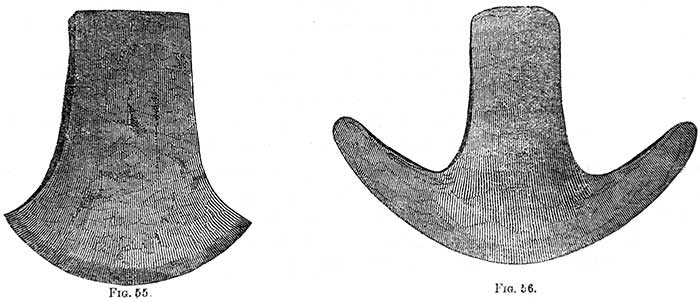
They were part of a deposit of two hundred and seventy-six, of like character, found buried in two large earthen vases, in the vicinity of Oxaca, and are of alloyed copper, and cast. "Such," says Du Paix, "are much sought by the silversmiths, on account of their fine alloy."
Fig. 57 is a chisel, of similar composition, found in the vicinity of Mexico, and also figured by Du Paix, It is engraved one fourth of the original size.
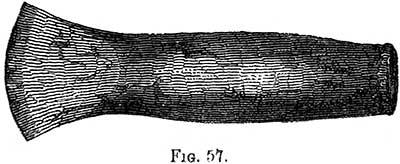
The methods in which these axes were used are well shown in the subjoined cuts, faithfully copied from the Mexican paintings, Figs. 58 and 59. They require no explanation beyond what is furnished by Clavigero, who says: "The Mexicans made use of an axe to cut trees, which was also made of copper, and was of the same form as those of modern times, except that we put the handle in an eye of the axe, while they put the axe in an eye of the handle." Fig. 60 is copied from the Mendoza Paintings, and represents a carpenter using one of these axes, or one very similar, adjusted, probably, so as to answer the purpose of an adze.

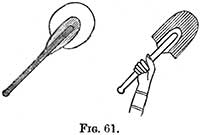 In the Mexican battle paintings, we occasionally
observe weapons, the blades of which were of copper,
as is shown by their green color, and which were used
something after the manner of the battle-axe. Examples
are here given, Fig. 61.
In the Mexican battle paintings, we occasionally
observe weapons, the blades of which were of copper,
as is shown by their green color, and which were used
something after the manner of the battle-axe. Examples
are here given, Fig. 61.
But although copper was used for such purposes, it does not appear that it entirely substituted itself for stone; for stone axes, and weapons formed by inserting blades of obsidian or itzli in solid pieces of wood, were common as late as the period of the Spanish conquest. The instrument this formed was called mahquahuitl, and was much dreaded by the Spaniards, who told wonderful stories of their efficiency, affirming that a single stroke was sufficient to cut a man through the middle, or decapitate a horse. Figs. 62 and 63 are examples from the paintings, and Fig. 64 is copied from the monuments at Chichen Itza, in Yucatan. The latter represents an axe, or rather, weapon of war, made by inserting blades of obsidian in a handle of wood, as above described. It will be seen by reference to Vol. I., p. 211, of these Contributions, that there is reason to believe that an entirely corresponding practice prevailed amongst the mound-builders. The device is an extremely simple one, and seems to have been common to many rude nations.

The copper axes of ancient Egypt closely resembled those above described, both in form and the mode of attachment to the handle. The accompanying illustration, Fig. 65, reduced from one of Visconti's plates, represents one of unique and ornamental workmanship. It will be observed that it is also lashed to the handle with thongs: differing from the primitive American axe, only in the manner of insertion. In this instance the broad end of the tool is sunk in the wood.
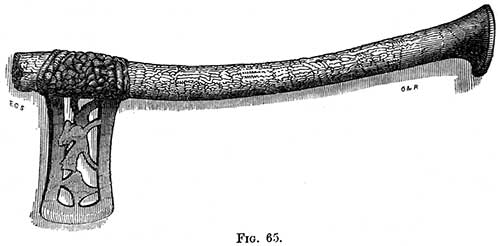
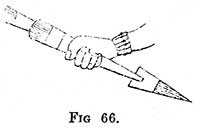 The Mexicans also used copper to point their spears and
arrows; although here obsidian was often substituted. Fig.
66 is a representation of a short javelin, which we find of frequent
occurrence in the paintings, and which seems to have
been used only in close combat. The long javelin, or that
which was thrown from the hand, is well shown in Fig. 67, which exhibits the
manner in which it was thrown, and also the xuiatlatli, or instrument used in
throwing it, and by means of which it was sent with greater accuracy and force
than could otherwise be attained. The gods are almost always represented, in the
mythological paintings, holding the xuiatlatli in their hands. It is often fancifully
ornamented with tassels and feathers.
The Mexicans also used copper to point their spears and
arrows; although here obsidian was often substituted. Fig.
66 is a representation of a short javelin, which we find of frequent
occurrence in the paintings, and which seems to have
been used only in close combat. The long javelin, or that
which was thrown from the hand, is well shown in Fig. 67, which exhibits the
manner in which it was thrown, and also the xuiatlatli, or instrument used in
throwing it, and by means of which it was sent with greater accuracy and force
than could otherwise be attained. The gods are almost always represented, in the
mythological paintings, holding the xuiatlatli in their hands. It is often fancifully
ornamented with tassels and feathers.

The Peruvians used copper for precisely the same purposes with the Mexicans. Says La Vega, "They make their arms, knives, carpenters' tools, large pins, hammers for their forges, and their mattocks, of copper; for which reason they seek it in preference to gold." And Ulloa adds, "The copper axes of the Peruvians differ very little in shape from ours; and it appears that these were the implements with which they performed most of their works. They are of various shapes and sizes; the edge of some is more circular than others, and some have a concave edge."—(Vol. I., p. 483.)
The knowledge of alloying was possessed by both the Mexicans and Peruvians, whereby they were enabled to make instruments of copper of sufficient hardness to answer the purposes for which steel is now deemed essential. Their works in stone and wood, whether in dressing the huge blocks of porphyry composing some of their structures, or in sculpturing the unique statues which are found scattered over the seats of their ancient cities, were carried on entirely with such instruments, or with still ruder ones of obsidian and other hard stones.
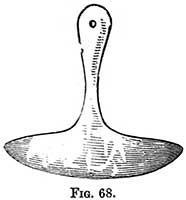 The metal used as an alloy was tin; and the various Peruvian articles subjected
to an analysis, are found to contain from three to six per cent of that metal. The
chisel analyzed by Humboldt contained copper 94, tin 6.—(Res, Vol. I., p. 260.)
Figure 68 is a reduced sketch of a copper knife found in
Peru, by J. H. Blake, Esq., of Boston. It has about four
percent of tin. This gentleman informs me, that "The
knives, gravers, and other implements found by myself in
Peru, contain from three and a half to four percent of tin,
which is sufficient to give them a very considerable degree
of hardness.2 The knives which I send you were found
about the person of a mummy which I took from an ancient
cemetery near Arico. Various household articles were found
with it; but these were the only ones of metal, except a medal of silver suspended
around the neck. The chisels or gravers are pointed at one end, with a cutting
edge at the broad part. They were found at various places in the northern part
of Peru. At the ancient city of Atacama, I found several hoes of copper, shaped
very much like the 'grubbing-hoes' to be found in our warehouses."
The metal used as an alloy was tin; and the various Peruvian articles subjected
to an analysis, are found to contain from three to six per cent of that metal. The
chisel analyzed by Humboldt contained copper 94, tin 6.—(Res, Vol. I., p. 260.)
Figure 68 is a reduced sketch of a copper knife found in
Peru, by J. H. Blake, Esq., of Boston. It has about four
percent of tin. This gentleman informs me, that "The
knives, gravers, and other implements found by myself in
Peru, contain from three and a half to four percent of tin,
which is sufficient to give them a very considerable degree
of hardness.2 The knives which I send you were found
about the person of a mummy which I took from an ancient
cemetery near Arico. Various household articles were found
with it; but these were the only ones of metal, except a medal of silver suspended
around the neck. The chisels or gravers are pointed at one end, with a cutting
edge at the broad part. They were found at various places in the northern part
of Peru. At the ancient city of Atacama, I found several hoes of copper, shaped
very much like the 'grubbing-hoes' to be found in our warehouses."

Figure 69 is a reduced sketch of an ancient Peruvian spear-head, of copper, found in a Peruvian huaca or tumulus, near Lima, whence it was brought by the late Dr. Marmaduke Burroughs, in 1826, and by him presented to Dr. S. G. Morton, of Philadelphia, in whose possession it now is. It is somewhat flattened, and regularly four-sided from the point to within a third of the distance from the larger end, where it becomes cylindrical. This part is hollow, for the reception of the handle. The metal is not hardened, and is now covered with a green oxyde. The length of the weapon is seventeen inches, and the diameter, at the larger end, one inch and one-tenth.
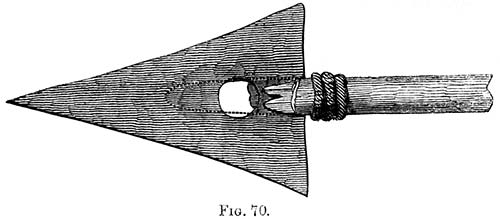
Figure 70 is a full-size engraving of one of the arrow-points discovered with a skeleton, near Fall River, Massachusetts, in the year 1831. With this skeleton were found a corroded plate of brass, supposed to have constituted a breastplate, and a number of rude tubes of the same metal, composing a sort of belt or cincture. The arrow-points are two inches in length, and one and one-third inches broad at the base. This skeleton attracted a good deal of attention at the time, and was supposed to lend some sanction to the then popular theory of the early discovery and settlement of the coast of New England by the Northmen. An analysis of the compound metal of which the relics were composed, was made by Berzelius, under the direction of the Royal Society of Antiquaries of Denmark. The result of the analysis was published by that learned body, in the following comparative table:
| Copper. | Zinc. | Tin. | Lead. | Iron. | |
|---|---|---|---|---|---|
| Brass from Fall River, | 70.29 | 28.03 | 0.91 | 0.74 | 0.03 |
| Old Danish, | 67.13 | 20.39 | 9.24 | 3.39 | 0.11 |
| Modern Brass, | 70.16 | 27.45 | 0.79 | 0.20 | — |
It will be seen by the table, that the metallic relics found at Fall River bear in their composition a suspicious resemblance to modern brass. They certainly differ widely, in this respect, from any of the alloys of copper found elsewhere on the continent. Without alluding to the rudeness of the workmanship exhibited by the Fall River relics,—a rudeness entirely inconsistent with that stage of advancement indicated by a knowledge of smelting and alloying the metals,—the fact that the skeleton accompanying them was found buried, after the Indian mode, in a sitting posture, and enveloped in bark, places in a very strong light the probability that the burial was made subsequent to the first settlement of New England, in 1625, and that the relics were of native manufacture, from sheets or plates of brass obtained from the early colonists. This probability is further sustained, by the circumstance that a portion of the wood attached to the arrows was still preserved, as was also a large proportion of the bark envelope of the skeleton, at the time of its discovery; which could hardly be the case, if its interment had been made as early as the tenth century, which is the period assigned to the Scandinavian visits. It cannot be claimed that the preservative properties of the salts of the copper could have more than a very local application or influence.
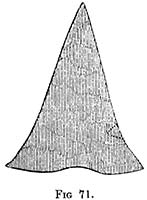 And while upon this point, it may be mentioned that Wood, in his "New England
Prospect," published in 1634, (p. 90,) distinctly states that the Indians obtained
brass of the English for their ornaments and arrow-heads, the last of which, he
adds, "they cut in the shape of a heart and triangle, and fastened in a slender piece of
wood, six or eight inches long"—in a manner, according to the description, precisely
similar to that observed in the articles found with the Fall River skeleton. If any
further evidence were needed to establish the opinions already advanced, it might
be found in the fact that, a few years ago, in the town of Medford, near Boston, in
Massachusetts, a skeleton was exhumed, accompanying which
were found some flint arrow-heads, and some brass arrow-points,
identical with those discovered at Fall River, together
with a knife of the English manufacture of two hundred years
ago. Fig. 71 is a full-sized engraving of the arrow-point in
question, which is now in the possession of the author.
And while upon this point, it may be mentioned that Wood, in his "New England
Prospect," published in 1634, (p. 90,) distinctly states that the Indians obtained
brass of the English for their ornaments and arrow-heads, the last of which, he
adds, "they cut in the shape of a heart and triangle, and fastened in a slender piece of
wood, six or eight inches long"—in a manner, according to the description, precisely
similar to that observed in the articles found with the Fall River skeleton. If any
further evidence were needed to establish the opinions already advanced, it might
be found in the fact that, a few years ago, in the town of Medford, near Boston, in
Massachusetts, a skeleton was exhumed, accompanying which
were found some flint arrow-heads, and some brass arrow-points,
identical with those discovered at Fall River, together
with a knife of the English manufacture of two hundred years
ago. Fig. 71 is a full-sized engraving of the arrow-point in
question, which is now in the possession of the author.
It has already been suggested that the shore of Lake Superior is the probable locality whence the copper used by the aborigines of, at least, the Eastern and Middle States was obtained. This suggestion is rendered more than probable by the fact that abundant traces of aboriginal mining have been discovered there in the course of recent explorations. Some of the more productive veins in the "Copper Region" seem to have been anciently worked to a considerable extent. The vein belonging to the "Minnesota Company" exhibits evidence of having been worked for a distance of two miles. The ancient operations are indicated by depressions or open cuts on the course of the vein. Upon excavating these, ample proofs of their artificial origin are discovered, consisting of broken implements of various kinds, stone axes, hammers, etc. Traces of fire are also frequent. Some of the excavations are found to have extended to the depth of thirty feet. In the mine of the particular company above named, covered by fifteen feet of accumulated soil, and beneath trees not less than four hundred years old, was found a mass of pure copper, weighing 11,537 lbs., from which every particle of the rock had been removed. It had been supported by skids, and was surrounded by traces of the tire which had probably been used to disengage the rock. Here, too, were found various rude implements of copper.
At the Copper Falls and Eagle River, as at the Vulcan and other mines, the ancient shafts are frequently discovered. Professor W. W. Mather, the eminent geologist, in a private letter, referring to the two mines first named, says: "On a hill, south of the Copper Falls Mine, is an excavation, several feet in depth and several rods in length, extending along the course of the river. Fragments of rock, etc., thrown out of the excavation, are piled up along its sides, the whole covered with soil, and overgrown with bushes and trees. On removing the accumulations from the excavation, stone axes of large size, made of green-stone, and shaped to receive withe handles, are found. Some large round green-stone masses, that had apparently been used for sledges, were also found. They had round holes bored in them to the depth of several inches, which seemed to have been designed for wooden plugs, to which withe handles might be attached, so that several men could swing them with sufficient force to break the rock and the projecting masses of copper. Some of them were broken, and some of the projecting ends of rock exhibited marks of having been battered in the manner here suggested."
The great Ontonagon mass of virgin copper, now deposited at Washington, when found, exhibited marks of having had considerable portions cut from it; and the ground around it was strewed with fragments of stone axes, which had been broken in endeavors to detach portions of the mass. It is not impossible that this mass was one of those which had been brought to the surface by the ancient miners.3
The questions naturally arise, By whom were these ancient mining operations carried on? and to what era may they be referred? Without noticing the improbable suggestion, that the various excavations which have been discovered are due to the French, (who, it is well known, were early acquainted, with the mineral riches of the Northwest,) we may find a satisfactory answer to the first of these questions, if not to the last, in the character of the deposits which recent explorations have disclosed from the mounds of the West. Among the multitude of relics of art found buried upon the ancient altars, or beside the bones of the dead, articles of copper are of common occurrence. It is sometimes found in native masses, but generally worked into articles of use or ornament. I have taken from the mounds axes, well wrought from single pieces, weighing upwards of two pounds each. They are symmetrical, corresponding very nearly in shape with the Mexican and Peruvian axes. Some are double-bladed, others gouge-shaped, and evidently designed to be used as adzes. Beside these, chisels, graving tools, and a great variety of ornaments, bracelets, gorgets, beads, etc., etc., composed of this metal, have been discovered. Some of the ornaments are covered with silver, beaten to great thinness, and so closely wrapped around the copper that many persons have supposed that the ancient people understood the difficult art of plating.
Some years ago, a mass of native copper, weighing upwards of twenty pounds, was found upon the banks of the Scioto River, near Chilicothe, in Ohio. Large portions had evidently been cut from it. The discovery of these native masses, not to mention the amount of the manufactured copper, implying a large original supply, points pretty certainly to the shores of Lake Superior as the locality whence the metal was obtained. There are other circumstances, still more conclusive, and which, taken in connection with the traces of ancient mining in the mineral region, leave no room to doubt that the race of the mounds obtained their supplies of copper from that direction. It is well known that while some of the Lake Superior copper is almost perfectly pure, a part is alloyed with silver in various proportions, and some is found having crystals of silver attached to it,—a peculiar mechanico-chemical combination, known to exist nowhere except in this region. This characteristic combination has been observed in some of the specimens, both worked and unworked, found in the mounds, and enables us to identify fully their primitive locality. The great industry and skill which the mound-builders displayed in the numerous and often gigantic monuments which they have left us at the West, warrant us in ascribing the ancient excavations, etc., in the mineral region to them. The Indian hunter is proverbially averse to labor; and we have no instance of the Indians undertaking works of this extent. Still, it cannot be doubted that they also obtained copper from this region. Indeed, we have direct evidence of the fact; but it is probable that they procured it only in small quantities, when it was found exposed at the surface, or on the banks of streams. Alexander Henry, who penetrated to Lake Superior at the period of the second French war, assures us that the Indians obtained copper here, which they "made into bracelets, spoons," etc.—(Travels, p. 195.) As we have seen, the early explorers on the coasts of New England, New York, Virginia, the Carolinas, and Florida, among whom we may mention Hudson, Verrazano, Raleigh, Heriot, Ribaude, De Soto, all concur in saying that the Indians had copper in small quantities among them, which they worked into pipes and ornaments. De Soto found copper hatchets among some of the tribes along the Gulf, which they professed to have obtained from "a province called Chisca, far toward the North."
All the copper found in the mounds appears to have been worked in a cold state; and although the axes and other instruments appear to be harder than the copper of commerce, they have been found, upon analysis, to be destitute of alloy. The superior hardness which they possess over the unworked metal, is doubtless due to the hammering to which they have been subjected. Some of the sculptures in porphyry, and other hard stones found in the mounds, exhibit traces of having been cut; but as they now turn the edge of the best tempered knife, we are at a loss to conjecture how they were so elaborately and delicately worked. The lack of cutting implements, among most rude people, is partially met by various contrivances, the most common of which is attrition, or rubbing or grinding on hard stones. It was thus the stone axes, etc., of the early Indians were slowly and laboriously brought into shape. It however needs but a single glance at the mound sculptures to convince the observer that such rude means are wholly inadequate to the production of works possessing so much delicacy of execution.
The Mexicans and Peruvians were wholly unacquainted with the use of iron; and their carvings, etc., were all wrought with copper tools. They, however, contrived to harden them with an alloy of from three to seven percent of tin. I have some of their implements in my possession, which answer a very good cutting purpose. It nevertheless seems incomprehensible how their extensive works in granite, porphyry, and other obstinate materials, could be carried on with such aids. The Egyptians, although not ignorant of iron, were compelled, by a variety of circumstances, to use copper tools, and with these most of their gigantic labors were effected. They must of necessity have had some means of hardening the metals; yet it is a singular fact, that, with the exception of a few bronze weapons of probably a comparatively late date, the chisels and other implements found in the monuments and at the quarries are pure copper.
1. Lieut. H. U. Flagg, Trans. Am. Association, 6th Meeting, p. 40. It is unnecessary to remark, that all accounts of the discovery of iron in the mounds, or under such circumstances as to imply a date prior to the Discovery, are sufficiently vague and unsatisfactory. The fragment of an iron wedge, found in a rock near Salem, Washington County, Ohio, and which has been alluded to by several writers upon American antiquities, does not probably possess an antiquity of more than fifty years. It is now in the possession of Dr. S. P. Hildreth, of Marietta; and its history, stripped of all that is not well authenticated, is simply that it was found fastened in the cleft of a rock, and no one could tell how it came there! The author of the paper on American antiquities, in the first volume of the Archaeologia Americana, states that, in a mound at Circleville, Ohio, was found amongst other articles "a plate of iron which had become an oxyde; but before it was disturbed by the spade, resembled a plate of cast iron. (Archaeol. Am., Vol I., p. 178.) It is obviously no easy matter to detect iron when fully oxydized in the earth; and when we are obliged to base our conclusions respecting the use of that metal, by an evidently rude people, upon such remains, if any there be, the strictest examination should be given them; appearances alone should be disregarded, and conclusions, after all, drawn with extreme caution. Whether it is likely the requisite discrimination and judgment were exercised in this case, it is not undertaken to say. But few masses of native iron, and these of small size and meteoric origin, have been found in this country; consequently the presence of iron to any extent amongst the mound-builders, can be accounted for only on the assumption that they understood the difficult art of reducing it from the ores, which involves a degree of knowledge, and an advance in the arts of civilization, not attained by the Mexicans nor by the Peruvians, and not sustained by the authenticated remains of the mounds.
2. The Indians of Chile, previous to the discovery by the Spaniards, made use of a kind of bronze metal, found native in the country, which is an alloy of copper, zinc, and antimony, called campañil by the Spaniards. From this they formed their cutting instruments.—(Mier's Trav., Vol. Il., p. 464.)
3. Since the above was written, the subjoined additional facts have been published in the Lake Superior Journal newspaper, of the date of September 25, 1850: "We have been shown by Charles Whittlesey, Esq., of the Ontonagon Mine, a copper arrow-head, and a piece of human skull and other bones, which have lately been found in the ancient Indian excavations on the Ontonagon River. The arrow-head is now about two inches in length, and seems to have had originally a socket, though but part of it remains. Several chisels, or instruments resembling chisels, having sockets like the common carpenter's chisel, and small gads or wedges, have also been found at the Minnesota Mine.
"But the greatest curiosity we have seen in the way of these articles is a stick of oak timber lately taken out of one of the ancient 'pits,' or shafts, at the Minnesota Mine, twenty-seven feet below the surface. It is a small tree, about ten feet in length, and eight or ten inches in diameter, having short limbs two feet apart, and at nearly right angles with one another; and on this account, and from its standing nearly upright, it is supposed to have been used as a ladder by the ancient miners. In this shaft, and around and over this stick, were rocks and earth, and large trees were growing over it Many centuries must have elapsed since that ancient ladder was placed there."

